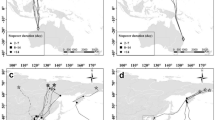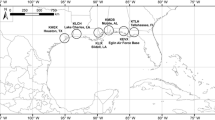Abstract
Suichuan is the second largest avian migration passage in China, while studies about local migration situation were rarely conducted. In this study, it aimed to provide the primary understanding of migration in Suichuan. The scale and diversity of migrants were analyzed. Moreover, the relationship between weather conditions including wind and rainfall and ringing intensity were also explored. Based on the field collected data from 2005 to 2010, dominant migrants in Suichuan were Ciconiiformes and Passeriformes, followed by Gruiformes, and the diversity of migrant species peaked in 2007. Correlations of bird ringing intensity with wind speed and rainfall were derived through a univariate analysis. Different groups of migrants shared different correlation patterns with each weather condition. Ringing intensity of small size Passeriformes was most easily affected by the adverse weather conditions (daily rainfall ≥15 mm or wind speed >2.5 ms−1); Gruiformes shared significant correlations with wind speeds <1.5 ms−1 and at 1.5–2.5 ms−1; whereas the large size Ciconiiformes showed non-significant relationships with both two meteorological variables. Totally, ringing intensity had significant negative correlations with frequencies of daily rainfall ≥15 mm and wind speed >2.5 ms−1. Multiple linear regression analysis confirmed that higher rainfall and stronger wind hampered total ringing intensity and these two predictors together could explain 79 % of the variation of total ringing intensity. Moreover, east wind was related to higher ringing intensity, especially for the groups of Ciconiiformes and others. The result of this exploratory study has important implications for assessing the impact of meteorological variables, such as wind and rain on migratory behavior in Suichuan.







Similar content being viewed by others
References
Able KP (1973) The role of weather variables and flight direction in determining the magnitude of nocturnal bird migration. Ecology 54:1031–1041
Åkesson S, Hedenström A (2000) Wind selectivity of migratory flight departures in birds. Behav Ecol Sociobiol 47:140–144
Alerstam T (1976) Nocturnal migration of thrushes (Turdus spp.) in southern Sweden. Oikos 27:457–475
Alerstam T (1979) Optimal use of wind by migrating birds: combined drift and overcompensation. J Theor Biol 79:341–353
Alerstam T (1993) Bird migration. Cambridge University Press, London
Alves JA, Gunnarsson TG, Potts PM, Gélinaud G, Sutherland WJ, Gill JA (2012) Overtaking on migration: does longer distance migration always incur a penalty? Oikos 121:464–470
Arizaga J, Belda EJ, Barba E (2011) Effect of fuel load, date, rain and wind on departure decisions of a migratory passerine. J Ornithol 152:991–999
Bächler E et al (2010) Year-round tracking of small trans-Saharan migrants using light-level geolocators. PLoS ONE 5:e9566
Berthold P (2001) Bird migration: a general survey. Oxford University Press, Oxford
Berthold P, Terrill S (1991) Recent advances in studies of bird migration. Annu Rev Ecol Syst 22:357–378
Bingman VP, Able KP, Kerlinger P (1982) Wind drift, compensation, and the use of landmarks by nocturnal bird migrants. Anim Behav 30:49–53
Bloch R, Bruderer B (1982) The air speed of migrating birds and its relationship to the wind. Behav Ecol Sociobiol 11:19–24
Bruderer B (1997) The study of bird migration by radar part 2: major achievements. Naturwissenschaften 84:45–54
Bruderer B, Underhill L, Liechti F (1995) Altitude choice by night migrants in a desert area predicted by meteorological factors. Ibis 137:44–55
Dänhardt J, Lindström Å (2001) Optimal departure decisions of songbirds from an experimental stopover site and the significance of weather. Anim Behav 62:235–243
Erni B, Liechti F, Underhill LG, Bruderer B (2002) Wind and rain govern the intensity of nocturnal bird migration in central Europe—a log-linear regression analysis. Ardea 90:155–166
Fiedler W (2009) New technologies for monitoring bird migration and behaviour. Ringing Migr 24:175–179
Gill RE et al (2009) Extreme endurance flights by landbirds crossing the Pacific Ocean: ecological corridor rather than barrier? Proc Roy Soc B Biol Sci 276:447–457
Hedenström A, Alerstam T (1997) Optimum fuel loads in migratory birds: distinguishing between time and energy minimization. J Theor Biol 189:227–234
Karlsson H, Nilsson C, Bäckman J, Alerstam T (2011) Nocturnal passerine migration without tailwind assistance. Ibis 153:485–493
Lack D (1960) The influence of weather on passerine migration. A review. Auk 77:171–209
Liechti F (2006) Birds: blowin’by the wind? J Ornithol 147:202–211
Liechti F, Bruderer B (1998) The relevance of wind for optimal migration theory. J Avian Biol 29:561–568
Liechti F, Klaassen M, Bruderer B (2000) Predicting migratory flight altitudes by physiological migration models. Auk 117:205–214
Marra PP, Francis CM, Mulvihill RS, Moore FR (2005) The influence of climate on the timing and rate of spring bird migration. Oecologia 142:307–315
Newton I (2006) Can conditions experienced during migration limit the population levels of birds? J Ornithol 147:146–166
Richardson WJ (1978) Timing and amount of bird migration in relation to weather: a review. Oikos 30:224–272
Richardson W (1990) Timing of bird migration in relation to weather: updated review. In: Gwinner E (ed) Bird migration-physiology and ecophysiology. Springer, Berlin, pp 78–101
Schaub M, Jenni L (2000) Fuel deposition of three passerine bird species along the migration route. Oecologia 122:306–317
Schaub M, Jenni L (2001) Stopover durations of three warbler species along their autumn migration route. Oecologia 128:217–227
Schaub M, Liechti F, Jenni L (2004) Departure of migrating European robins, Erithacus rubecula from a stopover site in relation to wind and rain. Anim Behav 67:229–237
Shamoun-Baranes J, Bouten W, van Loon EE (2010a) Integrating meteorology into research on migration. Integr Comp Biol 50:280–292
Shamoun-Baranes J, Leyrer J, Van Loon E, Bocher P, Robin F, Meunier F, Piersma T (2010b) Stochastic atmospheric assistance and the use of emergency staging sites by migrants. Proc Roy Soc B Biol Sci 277:1505–1511
Spellerberg IF, Fedor PJ (2003) A tribute to Claude Shannon (1916–2001) and a plea for more rigorous use of species richness, species diversity and the ‘Shannon–Wiener’ index. Glob Ecol Biogeogr 12:177–179
Taylor PD, Mackenzie SA, Thurber BG, Calvert AM, Mills AM, McGuire LP, Guglielmo CG (2011) Landscape movements of migratory birds and bats reveal an expanded scale of stopover. PLoS ONE 6:e27054
Van Belle J, Shamoun-Baranes J, Van Loon E, Bouten W (2007) An operational model predicting autumn bird migration intensities for flight safety. J Appl Ecol 44:864–874
Wang L, Zhu JH, Ma ZQ (2012) Effects of Beipiao wind power development planning on local birds ecosystem. Appl Mech Mater 214:445–450
Weber TP, Hedenström A (2000) Optimal stopover decisions under wind influence: the effects of correlated winds. J Theor Biol 205:95–104
Weber TP, Alerstam T, Hedenström A (1998) Stopover decisions under wind influence. J Avian Biol 29:552–560
Weber TP, Fransson T, Houston AI (1999) Should I stay or should I go? Testing optimality models of stopover decisions in migrating birds. Behav Ecol Sociobiol 46:280–286
Zehnder S, Åkesson S, Liechti F, Bruderer B (2001) Nocturnal autumn bird migration at Falsterbo, South Sweden. J Avian Biol 32:239–248
Acknowledgments
We thank the Forestry Bureau of Suichuan for their support and work on local bird ringing. Anonymous bird experts and related workers made great contributions to this work and provided valuable knowledge on bird migration in Suichuan. This study was supported by the Ministry of Science and Technology, China, National Research Program (2012CB955501, 2012AA12A407), and the National Natural Science Foundation of China (41271099).
Author information
Authors and Affiliations
Corresponding author
Additional information
This article is part of a Topical Collection in Environmental Earth Sciences on “Environment and Health in China II”, guest edited by Tian-Xiang Yue, Cui Chen, Bing Xu and Olaf Kolditz.
Rights and permissions
About this article
Cite this article
Chen, L., Jin, Z., Dong, L. et al. Impact of weather conditions on ringing intensity in Suichuan avian passage, China. Environ Earth Sci 75, 1045 (2016). https://doi.org/10.1007/s12665-016-5331-0
Received:
Accepted:
Published:
DOI: https://doi.org/10.1007/s12665-016-5331-0




